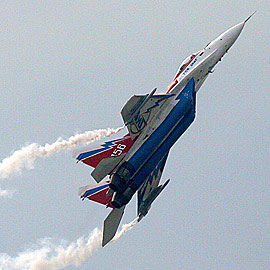November 06, 2007 (the date of publication in Russian)
Valery Zufman
RECOVERING FROM THE SPIN
Will Russian aircraft industry get second wind?
 Aerospace industry is one of the most technology-intensive niches of modern economy. The club of producers includes a dozen of countries, from which only three are capable to produce top-of-the-line technique: the United States, Russia, and the alliance of EU producers. Other nations have to address the leading trio for assistance, or to borrow from them technologies.
Aerospace industry is one of the most technology-intensive niches of modern economy. The club of producers includes a dozen of countries, from which only three are capable to produce top-of-the-line technique: the United States, Russia, and the alliance of EU producers. Other nations have to address the leading trio for assistance, or to borrow from them technologies.
The USSR's disintegration severely undermined a highly developed aerospace complex, both due to the general economic downfall and to the disruption of production chains, when a lot of industrial facilities were divided with newly-emerged political and economic borderlines.
The last year's record displays a turning point in Russia's development as an aircraft-producing power. In Russia's aerospace industry, technological innovations are still more available for military branches, while civilian industry tends to rely upon more traditional solutions.
The key developments of this year in Russia's aerospace industry included: the August aeroshow in Zhukovsky; resumption of international flights of Russian strategic aviation, and the consequent global discussion on goals and capabilities of military aviation.
The media coverage of the MAX-2007 aeroshow was scanty, reports more focused on poor management, queues and jams. However, this international exhibition was also remarkable for the amount of contracts signed by involved producers and traders. It is noteworthy that successful contracts prevailed in civilian aviation. MAX-2007 displayed a significant increase also in the variety of exhibited technique as compared with the 2005 show.
Russia's most remarkable project, presented at MAX-2007, was Superjet, a new regional plane designed by Sukhoy Corp.'s civil aviation division. The project enjoyed direct support from Russia's leadership. Given the current lack of financial resources for implementation of a variety of large-scale projects, a number of alternative designs were actually victimized in Superjet's favor – including unfortunately the practically completed Russian-Ukrainian AN-148 project.
One more deplorable aspect is the dependence of Russian designs from foreign-produced equipment. Though cooperation with Western producers is supposed to benefit expansion in foreign markets on the principle of exchange, costs of purchase restrict capabilities of modernization and new designing. Russia's aerospace industry is not yet capable to afford a high-cost design to be used only within the national borders. Insufficient financing also restricts the Superjet project to regional flights, while attempts to challenge Boeing and Airbus in long haul aren't yet undertaken.
Meanwhile, foreign equipment has got its own drawbacks, as it was demonstrated in September, when the novel Ka-226 helicopter perished due to ignition of the Rolls-Royce’s engine.
The decision of the Russian leadership to resume regular flights of strategic aviation provides a significant impetus for military aircraft industry. It was long-range aviation which fell the first sacrifice to the crisis of 1990s. Under today’s conditions of increasing global tensions, efficiency of the strategic system of nuclear deterrence, comprised of land-, sea- and air-based ballistic missiles, is becoming most crucial. In this context, resumption of strategic aviation’s regular patrol may be viewed as a logical element of the policy of Russia's leadership, along with modernization of Topol-M missiles, construction of new submarines if the 955 (Borei) design, equipped with currently tested Bulava missiles.
US media responded to the President's decision speculations over physical and moral exhaustion of Russian systems. However, some Western military observers admitted that Russia's TU-95 is not more outdated than the American B-52, while the modernized TU-160 is comparable in its technical characteristics with B-1. No wonder that the Americans hurried to exterminate the TU-160 aircrafts left in Ukraine after USSR's disintegration. Today, Russia is going to invest in a new version of this type of strategic bombers; these plans would be hardly expedient if it was really outdated.
The foundation of a unified aircraft-producing company is expected to enable Russia to build modern aviation technique, to mobilize the cadre potential, to expand in foreign markets and to retain Russia's status of a leading aviation power. Perspectives of development rely upon foreign sales. By 2015, Russia is going to control a 15% share of the global market of helicopters, also increasing influence at the market of war-planes. By that time, Russia plans to complete modernization of attack helicopters of the Air Forces, to increase the number of SU-34 bombers to 70, and to construct a multirole fifth-generation fighter plane. The achievements and initiatives of 2007 suggest that this year was critical in the history of domestic aircraft industry, designating consolidation of Russian aerospace industry’s position both in the world arena and in the domestic market.
Number of shows: 1890
 ENG
ENG 

 ENG
ENG 
